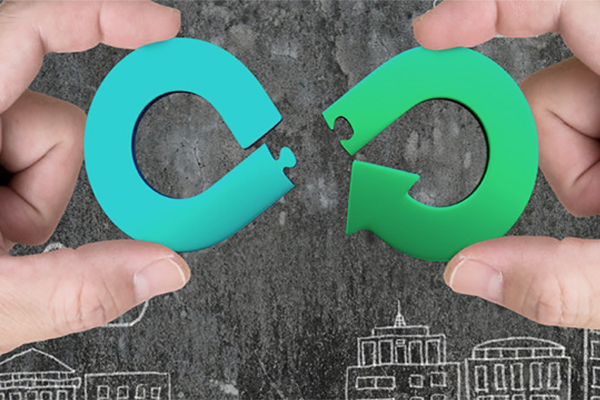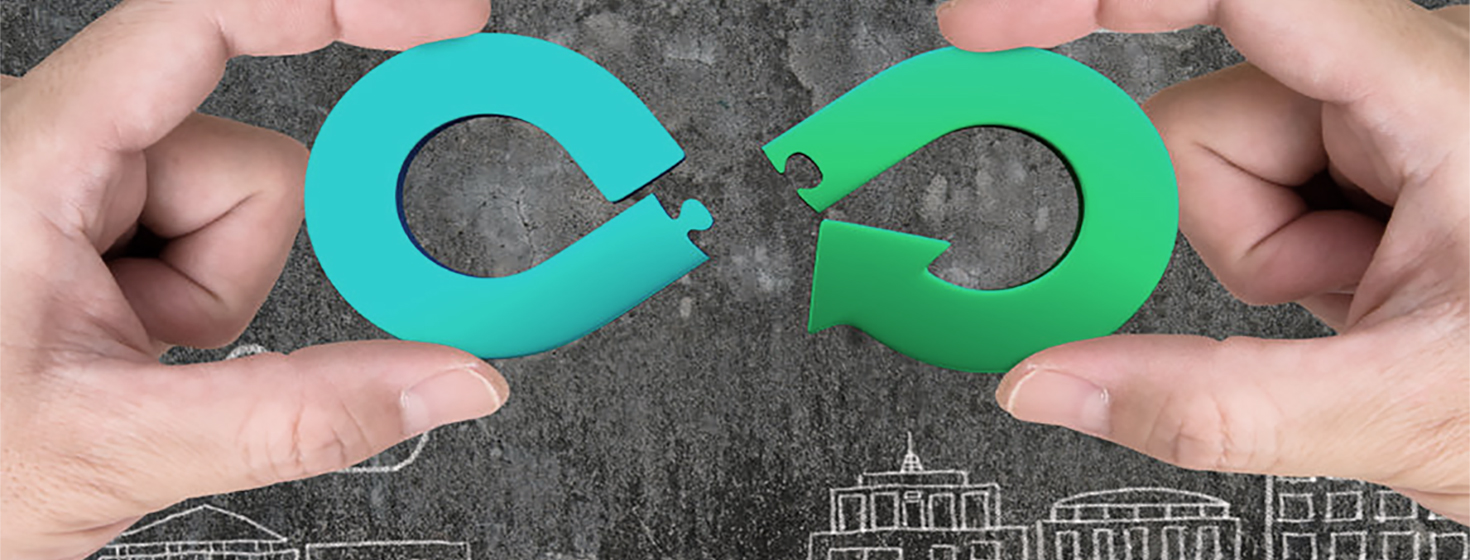The Circular Supply Chain Model
Since humans began making and distributing products to one another, the structure of the supply chain has remained predominantly untouched.
Raw materials flow in, are changed into a product and are then distributed and used until finally they are thrown away.
This linear chain has been sufficient to keep economies churning, but a new, more profitable supply chain methodology is gaining in popularity: the circular supply chain.
The circular supply chain is a model that encourages manufacturers and sellers of products to take discarded materials and remake them for resale.
The traditional model of “take, make, and throw away” is an economic dead-end and is costing businesses as they struggle with raw material costs and volatility.
Instead of producing one-time-use products, companies are refurbishing used parts or melting down products to turn back into their raw material form.
Instead of a linear “in and out” methodology, businesses are increasingly opting to loop their supply chains to cut down on costs and create less waste.
Contrary to popular belief, this process is actually more economical in the long run for companies. It’s the initial investment is process changes that cause many to ignore opportunities to reuse materials.
Once processes are in place, companies spend less money on raw materials, help the environment (which can result in government incentives), are at less risk of price volatility, and, perhaps most important of all, please their customers.
Here are some of the reasons why circular supply chains will replace linear supply chains in the 2020’s:
Save Money and Grow Business Value
The circular supply chain, at first glance, appears to predominantly be a methodology for companies to reduce environmental impact, but it’s much more than that.
By reusing parts and materials, companies can get the maximum benefit out of the raw materials they purchase.
Instead of throwing products away at the end of their lifecycle, they can be turned back into profit with lower costs than making a new product from scratch.
Throwing away products wastes the investment companies have already poured into the product (labor, materials, and energy).
It simply costs less to refurbish or recycle materials into new goods. By connecting the end of the linear supply chain with the beginning, companies can save money by reducing the overall cost of producing their products.
Societal Benefits of the Circular Economy
Going green remains a hot topic in just about every industry. The EPA reported that Americans produced 262.43 million tons of trash in 2015.
That’s up by about 3.5 million tons compared to 2014 and 54.1 million tons since 1990. As consumers create more and more waste each year, it’s up to both businesses and individual consumers to choose products that have small environmental footprints.
Consumers are increasingly conscious of their shopping decisions. According to a report by Nielsen, 66% of global consumers say they’re willing to pay more for sustainable brands. A full 73% of millennial shoppers (those born between 1977 – 1995) are willing to pay more for sustainable goods over traditional ones.
Companies that want to stay relevant and grow market share need to be catering to a public that is increasingly conscious of their environmental impact.
Recycling and Reusing Protects Against Price Volatility
Raw material prices are constantly a struggle for many companies trying to plan their budgets and keep the total costs of goods under control. Many categories of virgin materials are constantly shifting in price, especially metals which have seen more volatility recently than any decade in the 20th century.
By anticipating the amount of reused and recycled materials that can be used in the production of new goods, companies can more accurately gauge their expenditures and keep costs under control.
Circular Supply Chains Help Companies Meet Regulation Standards
Many government regulations are pushing businesses to adopt the circular supply chain by creating laws and regulations around recycling and waste disposal.
Others are offering incentives to companies that make active efforts to “go green,” no matter whether their end goal is to reduce the environmental impact of simply boost their bottom lines.
These are some examples of laws around the world that are now in place:
- EU Packaging Directive – requires all countries in the EU to recycle 50% of their packaging waste.
- Japanese Recycling Laws – require businesses to recycle packaging materials into something reusable.
- California Recycled Content Laws – no plastic bags, 25% of all plastic containers must be recycled, and more.
- UK Landfill Directive – all UK-based companies must recycle or treat their waste products, regardless of their size and turnover.
Circular Supply Chain Success Stories
Nike’s “Reuse-A-Shoe” program and Adidas’s partnership with Parley for the Oceans are demonstrating the power of the circular supply chain. Nike encourages customers to recycle their old shoes at local Nike sellers.
Those old shoes are then turned into Nike “grind material” and transformed back into new shoes for sale. Not only does this keep old shoes out of landfills, it helps boost Nike’s image and saves them on material costs.
Adidas is perhaps even more famous for its circular supply chain project. They have pledged to make 11 million sneakers out of recycled plastics pulled from the ocean. They have already seen tremendous success with their recycled line of shoes and are on track to make $1 billion helpings solve the problem of ocean plastic.
One company that began using the circular supply chain model even before the term was coined is Renault, a French vehicle manufacturer located outside of Paris. In 1949, the company was looking for ways to recover from the devastating effects of WWII. They began offering used vehicle parts at discounts between 30 – 50%, but with the same warranties and guarantees as new parts.
Their goal was entirely to drive profits and create a business that could flourish in an economy low on raw materials. Today, that same plant outside of Paris generates annual revenue of roughly $270 million! Now, it even designs its major vehicle components to be easy to disassemble for even more profitability.
The Circular Supply Chain is the Future
If you’ve ever heard the quote, “One man’s trash is another man’s treasure,” you can understand the concept of the circular supply chain.
Circular supply chains turn waste into opportunities as regulations on recycling and proper disposal of manufacturing byproducts become tighter. Often byproducts can be reclaimed and re-used within the manufacturing process where companies can develop new revenue sources for products that were previously discarded.
Companies looking to stay profitable in the 2020’s will be looking for ways to reduce their costs and please their customers. Adopting the circular supply chain methodology, therefore, just makes sense.
There are many ways to reduce the environmental impact of shipping freight, if you’re interested in learning more, click here to see how Kuebix helps shippers reduce theirs.
Source: Why Circular Supply Chains Will Replace Linear Supply Chains in the 2020’s
Related Article: Circular Supply Chain – The Missing Link
Putting Community in TMS: Enabling the Network Effect in Transportation Management
In this eBook, Adrian Gonzalez, President, Adelante SCM in partnership with Kuebix TMS, describes how transportation management systems are transitioning from being “inside the four walls” applications to becoming operating systems that power transportation communities and enable network effects.
Transportation management systems are transitioning from being “inside the four walls” applications to becoming operating systems that power transportation communities and enable network effects.
Advancements in technology - most notably, cloud computing, software-as-a-service, application programming interfaces, and mobile computing - are making it easier for shippers, carriers, and brokers of all sizes, as well as private fleets and others in the transportation ecosystem, to more easily integrate and transact with one another.
The value-added benefits provided by network-based transportation management systems include smarter and faster freight capacity matching and the ability to leverage network-based business intelligence and analytics to discover and establish new business connections and to benchmark your transportation performance and metrics against the community as a whole.
Download the eBook Putting Community in TMS: Enabling the Network Effect in Transportation Management
More Resources from Kuebix
Article topics
Email Sign Up

















